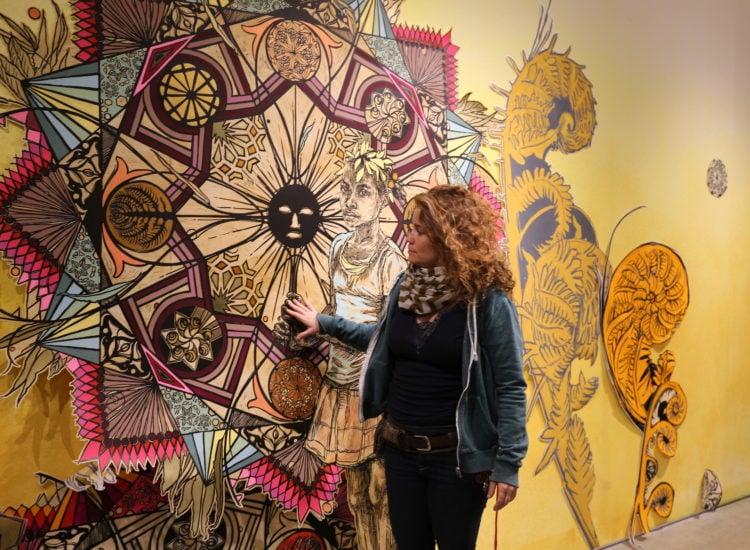Just weeks after her 20-foot-tall sculpture Thalassa went on display at the Detroit Institute of Arts, New York street artist Caledonia Curry—better known as Swoon—unveiled another large-scale installation as part of a solo exhibition at the Library Street Collective gallery in Downtown Detroit.
The 2,500-square-foot installation, The Light After (2016), employs hundreds of hand-cut paper and Mylar elements and the gallery’s architecture, a former vacuum cleaner factory built in 1926, to create a visual manifestation of the mystical. The rectangular storefront space of the gallery gives way to a passage that recalls that of the proverbial “light at the end of the tunnel,” which, in turn, leads into a more open, modern space—a former garage with floor-to-ceiling windows—which Swoon has transformed into the installation’s so-called “meadow.”
The piece was inspired by a clairvoyant dream the artist had when her mother died, three years ago, one that she later identified as what’s called an empathetic death experience. The work’s aesthetic qualities mimic sensations associated with death, including serenity, warmth, dissolution, and the presence of a light.
“Each of the three spaces that the viewer moves through is translated into a specific phase often described by people having near-death experiences,” the artist told artnet News via email. “I found it almost uncanny, the way the existing rooms and hallways translated. Architecture reads as so many things for us, and translates so easily into deep symbolism about journeys and altered realities, and I think that’s a byproduct of how inextricably tied we are to the architecture of our spaces.”
Not every viewer will identify the symbolism, Swoon acknowledges, but she finds that even they can have an “easy enjoyment” of the work’s “dreamy and exuberant” qualities. All the same, she immediately found that her work resonated with one viewer in particular.
“On the night of the opening, a woman came up to me and told me about her experience having been hit by a bus, and what followed,” she said. “It was very emotional for both of us, because she connected very deeply with the work and I was so touched to know that the piece was truly communicating.”
In Detroit, where gentrification is a significant concern, Swoon’s prominent role in the local art community is undeniable: she first came to the city for the Allied Media Conference in 2006 before returning in 2010 to contribute to a Power House Productions project refashioning several abandoned houses on Detroit’s Moran Street, where she installed a number of her trademark wheat-paste paper portraits. Her two current exhibitions are accompanied by a community mural project in Detroit’s Jefferson-Chalmers neighborhood, which is being painted with assistance from local artists.
“Artists and public art have become catalysts in the urban revitalization of Detroit, and Swoon has played an important role in our efforts to promote better relationships between the city and its suburbs,” said Library Street Collective owner Anthony Curis, a born-and-raised Detroiter who runs the gallery with his wife JJ, speaking to artnet News. “Her desire to consider the people that surround her public work makes it that much more important to the place it inhabits.”
“Swoon: The Light After” is on view through November 26 at 1260 Library Street, in Detroit.
